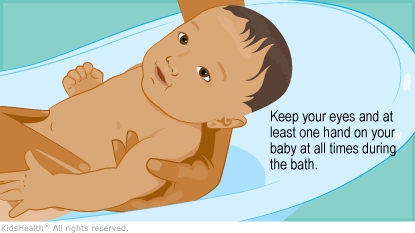Bathing keeps your baby's skin clean and can be enjoyable for you and your newborn. Give sponge baths until your baby's umbilical cord stump falls off and the circumcision heals (if your baby was circumcised). Then you can give your baby a bath in a small plastic infant tub or in a sink.

- Warm up the room before giving a bath.
- Bath water should be 90º–100ºF (32.2º–37.8ºC). To test the water temperature, feel the water with the inside of your elbow or wrist. It should feel warm, not hot.
- Be sure your water heater is set to 120ºF (49ºC) or lower to prevent burns.
For sponge baths:
- Fill two small, clean containers with warm water. Add a squirt of mild, fragrance-free liquid baby soap or baby shampoo to one of the containers.
- Put your baby on a dry towel on a safe, flat surface, such as a changing table or the floor. If your baby is on a changing table, keep your hand on your baby at all times and use the safety strap.
- Dampen one washcloth with plain water and one with soapy water.
- Wipe your infant's eyes (from the inner corner to the outer corner), face, and ears with the plain water-only washcloth. Pat dry.
- Using the soapy washcloth, gently wipe your baby's scalp. Then wipe the scalp with the wet water-only washcloth.
- Gently wash the rest of your baby with the soapy washcloth, paying special attention to creases under the arms, behind the ears, around the neck, and in the diaper area. Wipe from front to back in the diaper area. Then wipe gently with the plain water-only washcloth.
- Follow your health care provider's directions for cleaning your baby's umbilical cord stump.
For infant tub or sink baths:
- Put 2 inches of warm (not hot) water in a clean infant tub or a sink. If needed, you can line the infant tub or sink with a towel to prevent your baby from slipping or sliding.
- Support your baby's head with one hand and use the other hand to put the baby in the water feet-first up to the chest. Your baby's head and face should be well above the water.
- Use a clean, damp washcloth (without soap) to wipe your infant's eyes from the inner corner to the outer corner. Then clean the face and ears with the washcloth. Pat dry.
- Gently massage your baby's scalp with the washcloth and a small amount of liquid baby soap or baby shampoo.
- Cup your hand across the forehead to protect your baby's eyes as you rinse your baby's head.
- Gently wash the rest of your baby's body with water and a small amount of soap. Rinse.
- During the bath, keep gently pouring warm water on your baby's body so your little one doesn't get cold.
After the bath:
- Pat your baby's skin dry with a clean towel. Using a baby towel with a hood can help your little one stay warm.
- Apply lotion or oil only if your health care provider recommended it.
- Diaper and dress your baby.

How can I keep my baby safe during bathing? A baby can drown very quickly if left alone during a bath. Remember these safety tips:
- Gather all needed bath supplies before starting the bath.
- Always keep your eyes and at least one hand on your baby during the bath.
- Never leave your baby alone or turn away (even for a second) during bath time.
- Do not use a bath seat. A bath seat will not prevent drowning.
- If you need to leave during a bath, wrap your baby in a towel and take them with you.
- Do not put older kids in charge of bathing or watching your baby in the bath. Only a responsible adult should give a bath.
How often do I need to bathe my baby? In the first few months after birth, babies only need a bath 2 or 3 times a week. Bathing more often may dry out the skin.



